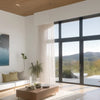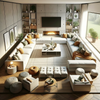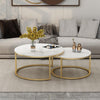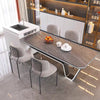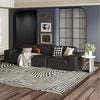The Ultimate Guide to Multipurpose Living Spaces: Enhance Interaction and Utility
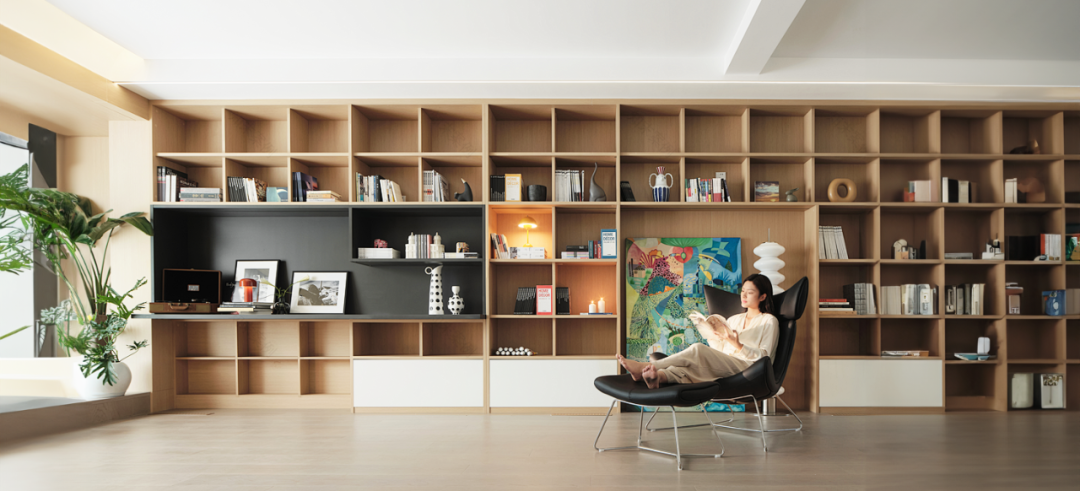
| Table of Contents |
|---|

Introduction
Decentralized living room design, also known as multipurpose living spaces, focuses on enhancing household flexibility and functionality by creating versatile areas that serve multiple purposes. This concept is gaining popularity in Southeast Asia and Malaysia, where optimizing limited space is essential due to high urban density and evolving lifestyle needs.
Modern lifestyles demand dynamic and adaptive living arrangements, leading more residents to adopt decentralized designs. These designs not only improve space utilization but also foster greater family interaction by removing unnecessary partitions.
This article will explore the necessity of living room-free designs, the advantages of multipurpose living spaces, practical applications, multifunctional furniture and modern coffee table designs, and the trend toward TV-free living spaces. By examining these aspects, we aim to provide a comprehensive understanding of how decentralized living room design enhances both the aesthetic and functional qualities of modern homes.
The Necessity of Living Room-Free Design
Space Limitations in Modern Small Homes
In Southeast Asia and Malaysia, the rapid pace of urbanization and rising housing costs have made small homes the choice for many families. However, these small homes often face significant space limitations. Traditional living room layouts can be impractical in such settings. Living room-free design addresses this issue by innovatively utilizing space and incorporating flexible furniture layouts, creating multipurpose living spaces that maximize utility.
For instance, in a 323-square-foot apartment in Budapest, designers used structural storage walls and detachable shelves that can be reconfigured as needed, maximizing the use of available space. This solution not only resolves space limitations but also offers various configuration possibilities, greatly enhancing the functionality of the space. In Hong Kong, designers have used foldable furniture and multifunctional wall systems to transform small spaces into different functional areas, such as bedrooms, offices, or living rooms, as required.

Changes in Modern Lifestyles
The fast pace of modern life requires more flexible and multifunctional living spaces. Open layouts and living room-free designs cater to this need. In Southeast Asia and Malaysia, residents increasingly value family interaction and spatial flexibility. Removing traditional living room walls and partitions facilitates better interaction among family members and provides more possibilities for various activities.
Open kitchen designs are particularly popular in this region. By removing unnecessary partitions, kitchens, dining areas, and living rooms are integrated into a single space, increasing the sense of openness and allowing for better interaction among family members during cooking, dining, and leisure activities. This design not only enhances space utilization but also brings more enjoyment and convenience to family life.
In a Bangkok home, designers used an open kitchen and dining area design to maximize space and enhance family interaction. This design meets modern demands for flexibility and multifunctionality while improving the quality of family life.
Young People's Demand for Personalization, Flexibility, and Practicality
The younger generation has diverse and personalized demands for living spaces. They seek not only practical home designs but also spaces that reflect their lifestyle and taste. Living room-free design meets these demands through flexible layouts and multifunctional furniture.

In a 425-square-foot apartment in Florence, designers used foldable panels and integrated furniture to seamlessly combine work and living spaces. The panels can fold down to form workstations or dining tables, and built-in bookshelves and storage spaces greatly enhance space utilization. Similar designs are common in Taipei, where clever design and efficient space planning maximize the functionality of compact spaces.
In a young family’s home in Kuala Lumpur, designers used movable furniture and multifunctional layouts, allowing family members to reconfigure spaces as needed to meet different demands throughout the day. This design not only improves space utilization but also makes living more convenient and varied.
The necessity of living room-free design lies in its ability to comprehensively address the space limitations of small homes, adapt to the demands of modern fast-paced lifestyles, and meet young people's desires for personalization, flexibility, and practicality. By adopting living room-free design, small homes can achieve higher space utilization, enhance family interaction, and provide more comfortable and multifunctional living environments.
This design concept is becoming mainstream in Southeast Asia and Malaysia, reflecting the pursuit of efficient, flexible, and personalized living spaces. Through living room-free design, families can create infinite living possibilities within limited space, providing better support and assurance for modern life.

Advantages of Multipurpose Living Spaces: A Professional Perspective
Enhanced Space Utilization
In contemporary architecture and interior design, the shift towards multipurpose living spaces reflects a strategic response to the limitations of modern urban dwellings. By eliminating unnecessary walls and partitions, these open-plan layouts expand visual and usable space, making them particularly effective in small residences. For example, renovation projects that merge separate kitchen and dining areas into a single cohesive space not only improve natural lighting and ventilation but also enhance the overall functionality and aesthetic appeal of the home.

Boosted Family Interaction
Open layouts facilitate increased interaction and communication among family members, fostering a cohesive and dynamic family environment. In a large, barrier-free space, individuals engaged in different activities—like cooking and working from home—can easily converse and maintain visual contact. This setup is instrumental in strengthening family bonds. For instance, a family in California reconfigured their living area into an open-plan design, significantly enhancing the quality of their daily interactions and making gatherings more inclusive and engaging.
Flexible and Functional Living Arrangements
The flexibility of multipurpose living spaces allows for their adaptation to various daily needs, transitioning seamlessly between work, leisure, and family time. Furniture in these spaces is often modular or movable, enabling quick reconfiguration to suit different activities, such as a living area that doubles as a workspace during the day and a relaxation zone at night. In a notable project in Singapore, designers utilized movable screens and versatile furniture to transform an open space into a multifunctional area that includes a living room, a workspace, and a children’s play area, effectively catering to the diverse needs of family members at different times of the day.
These multipurpose designs not only maximize space utilization and enhance family interactions but also cater to the evolving demands of modern lifestyles, which prioritize flexibility, efficiency, and a balance between personal and shared spaces. The popularity of such designs continues to grow, driven by their ability to adapt to diverse living scenarios and their appeal in urban environments where space is at a premium.
The Multifunctional Application of Decentralized Living Room Design

Living Room Combined with Dining and Kitchen
The LDK layout, which combines living, dining and kitchen areas, is one of the most popular design trends in modern living spaces. This open-plan design significantly enhances the spaciousness and brightness of the space and enhances communication among family members. This design is particularly popular in Malaysia and Southeast Asia because it adapts to changes in modern lifestyles, maximizes space utilization, and meets the social dynamics of modern families. The Mews, an E&O residential project in Kuala Lumpur, showcases this open-plan living, dining and kitchen area design. This seamless integration of spaces creates a harmonious environment conducive to family interaction, making the space feel larger and more inviting.
Living Room Plus Study
Moving away from traditional layouts that often separate visual and functional spaces, the modern living room plus study design combines a workspace with the living area. This setup features workstations and extensive bookshelves instead of conventional TVs and background walls, making it suitable for home offices, personal study, and shared reading spaces. This design is increasingly relevant in Southeast Asia and Malaysia, aligning with the needs of modern life where home spaces are often multifunctional and adapt to various activities including work and leisure.
Living Room as a Media Space
Replacing traditional television sets with projectors and large screens transforms living rooms into cinema-like environments. This design choice not only saves space but also enhances the entertainment potential of the living area. The popularity of such media equipment is on the rise in Southeast Asia and Malaysia, reflecting regional growth in consumer electronics and a shift towards home entertainment systems that offer versatile viewing experiences.

Living Room Plus Play Area
Integrating children's play areas into home design is a great way to cater to the diverse needs of young family members. Children's play areas can include elements such as slides, climbing walls, game areas and reading corners, which not only provide a fun and attractive environment for children, but also help strengthen parent-child interaction.
As a case in point, the Serai Bukit Bandaraya residential project and Verticas Residensi apartment in Kuala Lumpur both designed their living rooms as children's play areas. They ensured that children had a dedicated play area by integrating facilities such as climbing walls, small slides, toy storage solutions and children's play areas without ruining the beauty of the entire living room. These designs have been widely welcomed in Malaysia and Southeast Asia, where family-oriented living spaces are highly valued.
Multifunctional Tea Room Design
Incorporating tea rooms into living spaces allows for multiple uses, reflecting the cultural significance of tea in Southeast Asia and Malaysia. These rooms can also be used as dining areas or reception spaces, blending modern living with cultural traditions. This aspect is well reflected in the Stonor 3 project and Le Nouvel KLCC project in Kuala Lumpur, where the design of these projects blends modern living with cultural traditions to create a multifunctional space that can be used for a variety of purposes, a tea room designed for leisure and social gatherings. The design reflects local cultural customs while providing a modern style to the traditional tea room layout.

Adjustable Tatami Design for Small Spaces
Tatami designs offer flexible solutions for small spaces, allowing for conversion between resting areas and social spaces. This approach is particularly popular in Southeast Asia and Malaysia for its space-saving and multifunctional characteristics.
The following are case studies that use adaptable tatami designs: First, The Ritz-Carlton Residences in Kuala Lumpur features an adaptable tatami room that can be converted into a living or lounge area. This design optimizes space utilization and provides a multifunctional solution for small living spaces. Second, Park Residences in Singapore uses tatami design to accommodate multiple functions, providing flexibility for small living spaces. This design meets the modern demand for adaptable and multifunctional home environments. Finally, 20trees in Kuala Lumpur uses tatami rooms to create multifunctional spaces that can adapt to different activities and times of the day. The design is particularly attractive for its ability to transform small spaces into functional and aesthetically pleasing living areas. These case studies demonstrate the versatility and practicality of open and multifunctional spaces.
These applications of decentralized living room design illustrate the versatility and practical benefits of embracing open and multifunctional spaces. By breaking down traditional barriers within the home, these designs not only optimize the use of space but also enhance the quality of daily life, reflecting a deeper understanding of the evolving needs of modern households.

Multifunctional Furniture and Modern Coffee Table Design
Balancing Work and Life at Home
As more residents in Malaysia and Southeast Asia adopt remote working, creating a balanced environment that accommodates both work and personal life is essential. Designing home offices that provide both efficiency and comfort is crucial for productivity and well-being.
Designing for Balance:
- Ergonomic Furniture: Investing in ergonomic chairs and adjustable desks helps maintain physical health and comfort, essential for prolonged work periods.
- Dedicated Work Zones: Creating a distinct workspace separate from living areas minimizes distractions and helps maintain a clear boundary between work and personal life.
Flexible Office Layouts
A flexible furniture layout ensures that home offices are both functional and aesthetically pleasing. Simple, yet efficient reception areas can enhance the overall look while ensuring the space meets all practical needs.
Key Elements:
- Modular Furniture: Using modular desks and storage solutions allows for easy reconfiguration based on current needs, whether for work or leisure.
- Minimalist Design: Incorporating minimalist design principles ensures a clutter-free environment, promoting focus and productivity.

Modern Coffee Table Design
Modern coffee tables are versatile pieces that serve multiple functions, making them integral to the decentralized living room design. These tables often act as central points for reading, working, and relaxation.
Multifunctional Coffee Tables:
- Foldable Coffee Tables: These designs can be easily stored away when not in use, freeing up space for other activities.
- Coffee Tables with Chairs: Integrated seating options make these tables ideal for both work and casual interactions.
- Glass Coffee Tables: Providing a sleek and modern aesthetic, glass coffee tables blend seamlessly with various interior designs.
Application of Coffee Tables in Decentralized Design
Coffee tables play a crucial role in multifunctional living spaces, acting as centers for various activities. They support reading, working, and leisure, making them indispensable in open-plan layouts.
Practical Examples:
- Reading and Relaxation: A well-placed coffee table can hold books, magazines, and beverages, creating a cozy reading nook.
- Work Surface: For those working from home, coffee tables can double as informal workspaces, especially when paired with ergonomic seating.
Modern and Minimalist Designs
Modern coffee table designs often feature minimalist aesthetics, focusing on functionality and simplicity.
Design Trends:
- Minimalist Design: Coffee tables with clean lines and minimal embellishments fit well in contemporary homes, promoting a sense of calm and order.
- Black Coffee Tables: Sleek black designs add a touch of sophistication and easily complement various decor styles.
- Timeless Designs: Classic coffee table designs that incorporate high-quality materials and craftsmanship ensure longevity and continued relevance in home decor.
Case Studies and Practical Implementations:
- The Clift, Singapore: This residential project features modular furniture and minimalist design elements in home offices, ensuring functionality and aesthetic appeal.
- Aria Luxury Residence, Kuala Lumpur: Incorporates multifunctional coffee tables in living areas, demonstrating their utility in modern, open-plan homes.
- Hatten City, Melaka: Highlights the use of glass and foldable coffee tables, showcasing how these designs enhance both functionality and visual appeal in small living spaces.
These examples demonstrate how multifunctional furniture and modern coffee table designs contribute to the effectiveness and appeal of decentralized living room spaces, optimizing both work and leisure activities in contemporary homes.

From TV-Centric to TV-Free Living Spaces
The traditional living room design, centered around the television, is gradually being replaced by more flexible and personalized layouts. This shift reflects a growing preference for multifunctional spaces that can adapt to various activities and lifestyles.
Evolving Design Preferences:
- Enhanced Social Interaction: By removing the central focus on the TV, living rooms can encourage more face-to-face interactions among family members and guests.
- Aesthetic Freedom: Without the TV as a focal point, homeowners have more freedom to design their living spaces in ways that reflect their personal style and preferences.
Flexible Use of Projectors
Projectors and retractable screens offer versatile alternatives to traditional televisions, providing greater flexibility in how living spaces are used and designed.
Benefits of Projectors:
- Space Efficiency: Projectors and screens can be hidden when not in use, freeing up wall space for other purposes such as artwork or storage.
- Versatile Viewing: Projectors allow for larger screen sizes and more flexible placement, making them ideal for movie nights, gaming, or presentations.
Practical Implementations:
- The Scotts Tower, Singapore: This residential project features living rooms equipped with projectors and retractable screens, allowing residents to transform their spaces from casual living areas to home theaters easily.
- Residensi Astrea, Kuala Lumpur: Utilizes hidden projection systems to provide a sleek, minimalist look while offering high-quality viewing experiences for residents.
- The Interlace, Singapore: Incorporates flexible projection setups in living rooms, showcasing the versatility of using projectors in modern home design.
By embracing TV-free designs and integrating projectors, these living spaces can adapt to the varied needs of modern households, enhancing both functionality and aesthetic appeal.
Conclusion
Decentralized living room design, also known as wallless or multipurpose living spaces, offers significant advantages that align with modern living needs. This innovative approach redefines traditional layouts by enhancing space efficiency, versatility, and family interaction. Particularly in regions like Malaysia and Southeast Asia, where optimizing limited space is crucial, these designs prove immensely beneficial.

Key Advantages
Decentralized living room designs maximize space utilization by eliminating unnecessary partitions, creating open and spacious environments. This approach supports various configurations for activities ranging from dining and entertainment to work and play. The integration of multifunctional furniture, such as adjustable tatami mats and versatile coffee tables, further enhances this flexibility, making the space adaptable to different needs and preferences.
Enhanced Family Interaction and Personalization
Open floor plans encourage interaction among family members, strengthening bonds and improving overall family dynamics. By integrating spaces such as kitchens or play areas, these designs foster environments conducive to social and communal living. Additionally, decentralized designs promote personalization, allowing homes to reflect the unique tastes and lifestyles of their residents. Whether incorporating a TV-free living room with integrated projection equipment or combining living and dining areas, these layouts demonstrate the practical and aesthetic diversity of modern design.
Improving Quality of Life
The flexibility and practicality of decentralized living room designs significantly enhance daily living quality. By employing these innovative approaches, residents can create multifunctional spaces that are both beautiful and functional. From ergonomic home office setups to modern coffee table designs, these spaces are designed to accommodate a variety of activities, improving overall comfort and usability.
In conclusion, decentralized living room design principles allow homeowners to create dynamic, versatile, and engaging living spaces. This approach not only maximizes space but also aligns with the contemporary desire for interactive and adaptable home environments. By integrating key elements from necessity, advantages, multifunctional applications, furniture design, and TV-free trends, these strategies enhance both the aesthetic and functional aspects of modern homes, making them more comfortable and efficient for daily living.
Explore our range of multifunctional coffee tables DPhome COFFEE TABLES that embody these principles, and find the perfect centerpiece for your evolving home space.
FAQs
1. What is multifunctional living?
2. What is a multipurpose home?
A multipurpose home is designed to support multiple activities within the same area. For instance, a living room might also serve as a dining area, home office, or playroom. This design maximizes space efficiency and allows for seamless transitions between different uses throughout the day.
3. How do you make a multipurpose space?
Creating a multipurpose space involves using flexible furniture, such as foldable tables and modular sofas, and incorporating movable partitions to define different areas. Additionally, using neutral colors and minimalist decor can help maintain a cohesive look while serving various functions.
4. What are multifunctional spaces?
Multifunctional spaces are areas within a home that are designed to serve multiple purposes. Examples include a living room that doubles as a dining area or an office that transforms into a guest room. These spaces are designed to be adaptable and efficient, making the most of every square foot.
5. What are some design ideas for multipurpose living spaces?
Design ideas for multipurpose living spaces include combining the living room with the kitchen (LDK layout), integrating home offices into living areas, using retractable screens or curtains to create temporary divisions, and incorporating built-in storage solutions. These strategies help create flexible, functional, and aesthetically pleasing environments.

